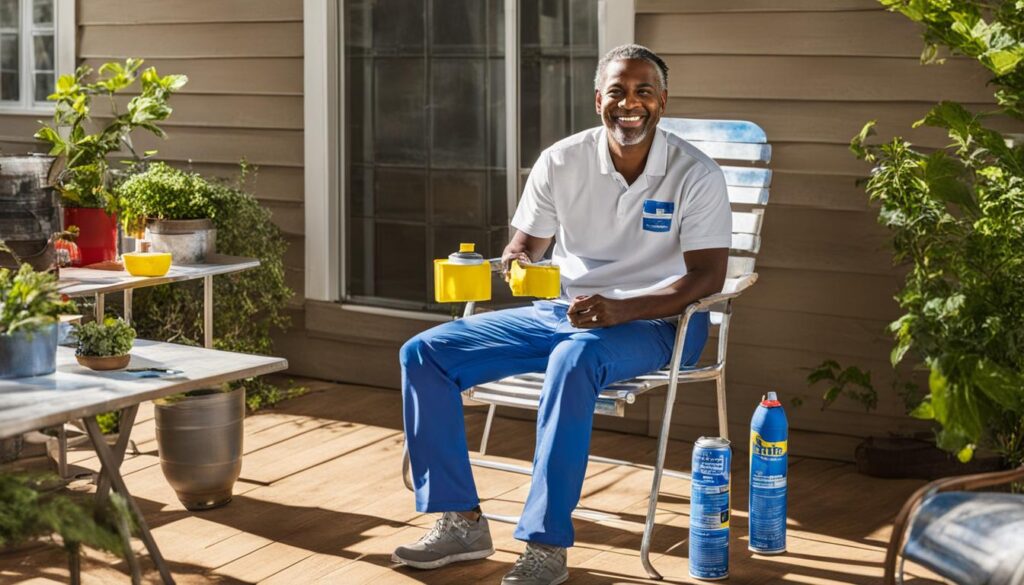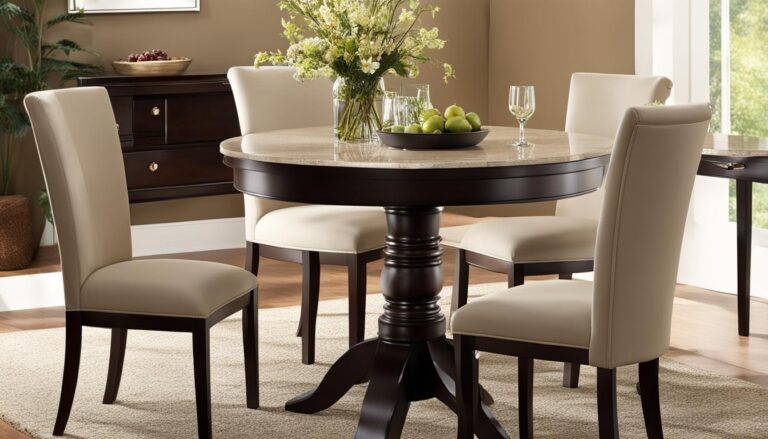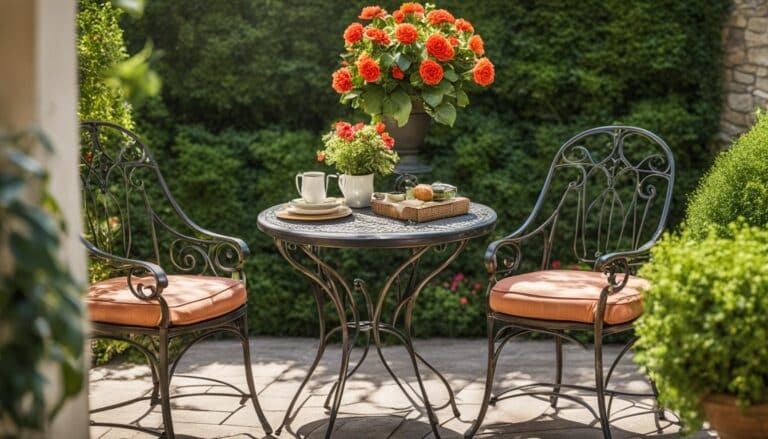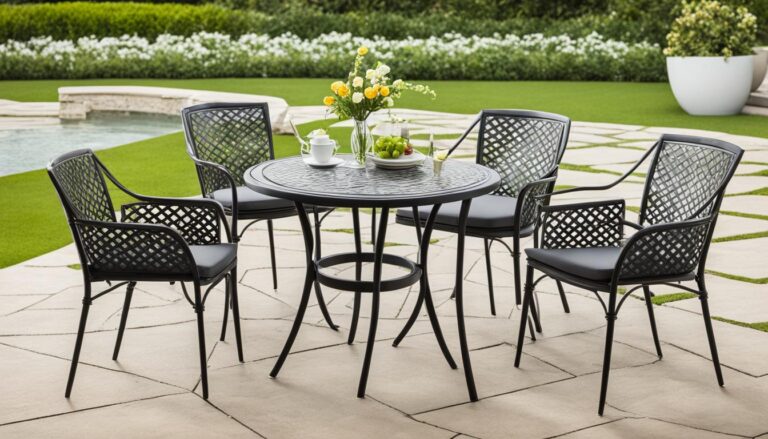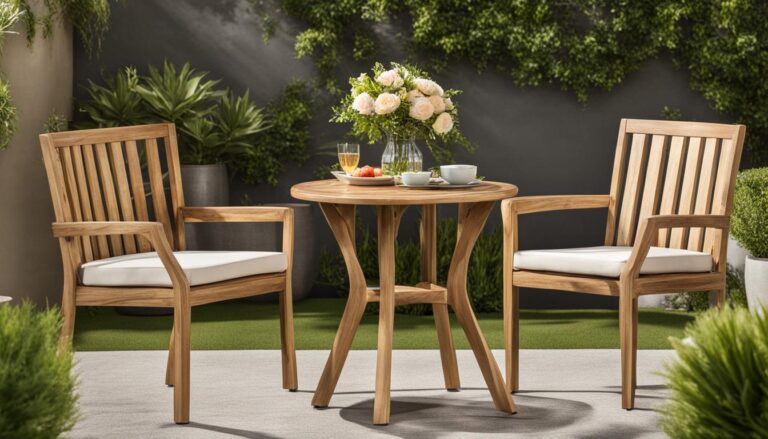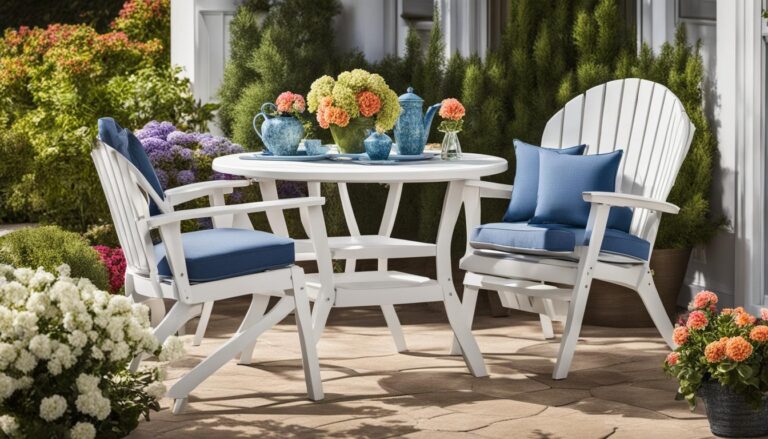Repainting aluminum patio furniture is a simple and cost-effective way to refresh the look of your outdoor space. With the right tools and supplies, you can easily transform your worn-out furniture into something new and beautiful. In this comprehensive guide, we will walk you through the step-by-step process of repainting aluminum patio furniture, from preparing the surface to applying the paint and protecting it for long-lasting results.
Key Takeaways:
- Repainting aluminum patio furniture can breathe new life into your outdoor space.
- Gather all the necessary tools and supplies before starting the repainting process.
- Clean the furniture thoroughly to remove dirt, dust, and grease before painting.
- Properly prepare the furniture by taping off areas you don’t want to paint and protecting the surrounding area.
- Apply multiple coats of paint and top coat varnish to achieve a durable and stylish finish.
Tools and Supplies You’ll Need
Before you embark on the task of repainting your aluminum patio furniture, it’s important to gather all the necessary tools and supplies. By having everything prepared, you can ensure a smooth and efficient painting process that yields beautiful results. Here’s a list of what you’ll need:
- Mineral spirits for cleaning the surface
- Paper towels
- Old cardboard or a tarp to protect your working area
- Rust-Oleum Metallic Oil Rubbed Bronze paint for a durable and stylish finish
- Top coat varnish in a satin finish for added protection
- Kraft or wrapping paper for taping off areas
- Painter’s tape
- Scissors
Having these tools and supplies at hand will make the repainting process much easier and ensure that you achieve professional-looking results.
Tools and Supplies You’ll Need
| Tools and Supplies | Description |
|---|---|
| Mineral spirits | To clean the surface |
| Paper towels | For cleaning and drying |
| Old cardboard or tarp | To protect your working area |
| Rust-Oleum Metallic Oil Rubbed Bronze paint | Durable and stylish finish |
| Top coat varnish | Satin finish for added protection |
| Kraft or wrapping paper | For taping off areas |
| Painter’s tape | To secure the paper and create clean lines |
| Scissors | To cut the paper and tape |
Gathering these tools and supplies will ensure that you have everything you need to successfully repaint your aluminum patio furniture.
Cleaning the Furniture
In order to ensure a successful repainting process, it is crucial to start with a clean surface. Cleaning your aluminum patio furniture will remove any dirt, dust, or grease that may hinder the paint from adhering properly. To begin, gather some paper towels and a bottle of mineral spirits or a similar cleaner. Apply the cleaner to a paper towel and thoroughly wipe down all areas of the furniture, including the hard-to-reach corners and crevices. This will ensure that the paint adheres evenly and provides a smooth and professional finish.
Removing Stubborn Stains
If your aluminum patio furniture has any stubborn stains or grime that cannot be removed with mineral spirits alone, you may need to use a more intensive cleaner. There are various commercial aluminum cleaners available on the market, or you can make your own cleaner by mixing equal parts water and vinegar. Apply the cleaner to a cloth or sponge and scrub the stained areas gently. Rinse the furniture with clean water and allow it to dry completely before proceeding to the next step.
Sanding the Surface
In some cases, your aluminum patio furniture may have a rough or oxidized surface that needs to be smoothed before painting. To do this, you can use a fine-grit sandpaper or a sanding block. Gently sand the entire surface of the furniture, focusing on any rough areas or peeling paint. This will create a smooth surface for the new paint to adhere to. After sanding, wipe away any dust with a clean cloth or tack cloth to ensure a clean surface for painting.
| Cleaning Tips | Preparation Tips |
|---|---|
|
|
Preparing the Furniture for Painting
Once you have cleaned the surface of your aluminum patio furniture, the next step is to prepare it for painting. This involves taping off areas that you do not want to get painted and protecting the surrounding area from overspray. By taking these precautions, you can ensure clean and professional-looking results.
1. Taping off Areas:
Use kraft or wrapping paper to tape off areas such as cushions, glass tabletops, or decorative accents that you do not want to paint. This will help you achieve clean lines and avoid any accidental paint application. Carefully position the paper and secure it with painter’s tape, ensuring that it covers the intended areas completely.
2. Protecting the Surrounding Area:
Cover the surrounding area with old cardboard or a tarp to protect it from overspray. This will prevent any paint particles from landing on surfaces that you do not want to paint. Make sure the cardboard or tarp is large enough to cover the entire working area and secure it in place to avoid movement during the painting process.
By taking the time to tape off areas and protect the surrounding space, you can ensure a smooth painting process and prevent any unwanted paint accidents. Once the furniture is properly prepared, you are ready to proceed with applying the paint.
| Taping off Areas | Protecting the Surrounding Area |
|---|---|
| – Use kraft or wrapping paper | – Cover the surrounding area with old cardboard or a tarp |
| – Secure the paper with painter’s tape | – Ensure the cardboard or tarp covers the entire working area |
Applying the Paint
Now that you have prepared your aluminum patio furniture, it’s time to apply the paint. This step will bring your furniture to life and give it a fresh new look. Follow these painting techniques for aluminum furniture to achieve the best results.
Step 1: Lightly Spray the First Coat
Using the Rust-Oleum Metallic Oil Rubbed Bronze paint, lightly spray the first coat onto your furniture. Make sure to hold the spray can at a distance of 8-12 inches from the surface and use sweeping motions to ensure an even application. Start from one end of the furniture and work your way to the other end, maintaining a consistent distance and coverage.
Step 2: Allow the First Coat to Dry
After applying the first coat, allow it to dry completely before applying additional coats. This is important to ensure proper adhesion and a smooth finish. Check the drying time mentioned on the paint can and follow the instructions accordingly.
Step 3: Apply Additional Coats, if Needed
Depending on the coverage and desired finish, you may need to apply two or three coats of paint. For a solid and long-lasting color, make sure to let each coat dry completely before proceeding to the next one. Apply the subsequent coats using the same technique as the first coat, maintaining an even layer of paint.
| Step | Painting Technique |
|---|---|
| Step 1 | Lightly spray the first coat, holding the spray can 8-12 inches away from the furniture and using sweeping motions. |
| Step 2 | Allow the first coat to dry completely. |
| Step 3 | If needed, apply additional coats, ensuring each coat dries before proceeding. |
By following these painting techniques, you can achieve a professional-looking finish on your aluminum patio furniture. Take your time and be patient during the painting process to ensure the best results. Once the paint has dried, you can move on to the next step of adding a top coat varnish for added protection and durability.
Adding the Top Coat Varnish
Once you have applied the desired number of coats of paint to your repainted aluminum patio furniture, it’s important to add a top coat varnish to protect the surface and ensure its longevity. The top coat varnish acts as a protective barrier against daily wear and tear, UV rays, and moisture, providing an extra layer of durability.
To apply the top coat varnish, simply follow these steps:
- Ensure that the painted surface is completely dry and free of any dust or debris.
- Using a clean brush or foam applicator, evenly apply the top coat varnish onto the painted furniture. Be sure to work in long, smooth strokes to achieve a uniform coverage.
- Allow the first coat of varnish to dry completely before applying the second coat. This will usually take a few hours, but refer to the product’s instructions for specific drying times.
- If desired, you can lightly sand the surface between coats using a fine-grit sandpaper. This will help create a smoother finish and remove any imperfections.
- Apply the second coat of varnish, following the same technique as the first coat. This will further enhance the protection and durability of the painted furniture.
- Allow the final coat of varnish to dry completely before using or placing any objects on the furniture. This will typically take at least 24 hours, or as directed by the product’s instructions.
By adding the top coat varnish, you are not only safeguarding your repainted aluminum patio furniture but also ensuring that it maintains its fresh and vibrant appearance for years to come. Remember to regularly clean the furniture and touch up any areas that may become chipped or faded to extend its lifespan even further.
Tips for Applying Top Coat Varnish:
- Choose a top coat varnish that is specifically designed for outdoor use and provides UV protection.
- Always read and follow the instructions provided by the manufacturer of the top coat varnish for best results.
- Apply the varnish in a well-ventilated area to avoid inhaling any fumes. If necessary, wear a mask and ensure proper airflow.
- Avoid applying the varnish in direct sunlight or on a hot day, as this can affect the drying process and result in an uneven finish.
- Store any leftover top coat varnish according to the manufacturer’s instructions to maintain its quality and shelf life.
| Benefits of Top Coat Varnish | Why Use Top Coat Varnish? |
|---|---|
| Provides an extra layer of protection against wear and tear | To increase the longevity of repainted aluminum patio furniture |
| Offers UV resistance to prevent color fading | To maintain the vibrant appearance of the furniture over time |
| Creates a durable and water-resistant finish | To protect against moisture and adverse weather conditions |
| Enhances the overall look and feel of the furniture | To achieve a professional and polished appearance |
Finishing Touches and Tips
Now that you’ve completed the repainting process, it’s time to add the finishing touches and make your newly repainted aluminum patio furniture shine. Here are some tips to help you achieve a polished and professional look:
Inspect and Touch Up
Take a close look at your furniture’s surface to check for any areas that might need touch-ups. Use the same paint color to fix small chips or missed spots. This will ensure a seamless and flawless finish.
Consider Adding Decorative Accents
To give your furniture a unique and personalized touch, consider adding decorative accents. You can use stencils to create intricate designs or apply a contrasting color to specific areas. Get creative and let your imagination guide you!
Protect and Maintain
To maintain the beauty and longevity of your repainted furniture, it’s important to protect it from the elements. Use furniture covers or store it indoors when not in use to prevent damage from rain, sun, or snow. Regularly clean the furniture with a mild soap and water solution to remove dirt and debris.
By following these finishing touches and tips, you can completely transform the look of your outdoor space with repainted aluminum patio furniture. Enjoy the fruits of your labor and create a welcoming and stylish oasis for relaxing and entertaining.
Maintain Your Repainted Furniture
Once you have put in the effort to repaint your aluminum patio furniture, it’s important to take the necessary steps to maintain its beauty and longevity. Here are some tips to help you keep your repainted furniture looking its best for years to come.
Clean Regularly
Regular cleaning is essential to remove dirt, dust, and debris that can accumulate on the surface of your furniture. Use mild soap and water to gently clean the painted areas, avoiding harsh cleaners or abrasive tools that can damage the paint. Rinse thoroughly and allow the furniture to dry completely before using or applying any additional treatments.
Avoid Scratches
To prevent scratches and scuffs on your repainted furniture, avoid dragging or sliding heavy objects across the surface. Consider using coasters or placemats under items to protect the paint from direct contact with hard surfaces. If you need to move the furniture, lift it gently rather than dragging it.
Touch Up as Needed
Over time, your repainted furniture may experience minor chips or fading. It’s important to address these issues promptly to maintain the overall appearance. Keep some extra paint on hand for touch-ups, and use a small brush to carefully apply paint to any damaged areas. Blend the touch-up paint with the surrounding surface for a seamless finish.
| Tip | Description |
|---|---|
| Use Furniture Covers | Protect your repainted furniture from harsh weather conditions by using covers when it’s not in use. This will shield it from excessive sun exposure, rain, and snow, helping to prolong the life of the paint and prevent any potential damage. |
| Inspect Regularly | Take the time to regularly inspect your repainted furniture for any signs of wear or damage. This will allow you to catch any issues early on and take the necessary steps to address them. Look for areas where the paint may be chipping, peeling, or fading, and take appropriate action to restore the appearance. |
| Store Properly | If you live in an area with harsh winter weather or extended periods of rain, consider storing your repainted furniture indoors or in a covered area during these seasons. This will help protect it from the elements and extend its lifespan. |
By following these maintenance tips, you can enjoy the beauty of your repainted aluminum patio furniture for years to come. With proper care and attention, your furniture will continue to enhance your outdoor space and provide a comfortable and stylish place to relax and entertain.
Conclusion
Congratulations on completing the process of repainting your aluminum patio furniture! With the DIY approach, you have successfully transformed your worn-out furniture into a fresh and beautiful addition to your outdoor space. By following our step-by-step guide, you have learned how to repurpose your existing furniture, saving you money and reducing waste.
Repainting outdoor furniture is not only a cost-effective solution but also a rewarding experience. You have the freedom to choose the color and finish that best suits your style and preferences. Whether you want to create a vibrant and colorful oasis or a more subtle and modern look, repainting allows you to customize your furniture to your heart’s desire.
Now that you have achieved a stunning new look, it’s important to maintain your repainted furniture properly. Regularly clean your furniture with mild soap and water to remove dirt and debris. This simple maintenance routine will help preserve the appearance and integrity of the paint, allowing you to enjoy your repainted furniture for years to come.
So, take a step back, relax, and admire your newly repainted aluminum patio furniture. You have not only given a new lease on life to your outdoor space but also contributed to a more sustainable and eco-friendly approach to home improvement. Enjoy your beautiful outdoor oasis!
FAQ
What tools and supplies do I need to repaint my aluminum patio furniture?
You will need mineral spirits, paper towels, old cardboard or a tarp, Rust-Oleum Metallic Oil Rubbed Bronze paint, top coat varnish, kraft or wrapping paper, painter’s tape, and scissors.
How do I clean the surface of my aluminum patio furniture before repainting?
Use a paper towel and mineral spirits or a similar cleaner to remove dirt, dust, and grease. Clean all areas of the furniture, including corners and crevices, for a smooth paint application.
How do I prepare my aluminum patio furniture for painting?
Tape off areas you don’t want to get painted, such as cushions or glass tabletops. Cover the surrounding area with cardboard or a tarp to protect it from overspray.
How do I apply the paint to my aluminum patio furniture?
Use Rust-Oleum Metallic Oil Rubbed Bronze paint and lightly spray one coat on the furniture. Apply additional coats as needed, and let each coat dry completely before proceeding.
Should I apply a top coat varnish to my repainted furniture?
Yes, it’s recommended to apply two coats of top coat varnish in a satin finish for added protection against wear, UV rays, and moisture.
How do I maintain my repainted aluminum patio furniture?
Regularly clean the furniture with mild soap and water to remove dirt and debris. Avoid using abrasive cleaners or tools that may scratch or damage the paint. Touch up any chips or fading with matching paint.

